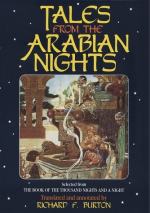- - U - | - - U - | Ya khatiba ’l-dunya ’l-dandy.
U U - U | U U - U - | Yati innaha sharaku ’l-rada
- - U - | - - U - | Darun mata ma azhakat,
- - U - | - - U - | Fi yaumiha abkat ghada,
with a different rhyme and of a different variation of metre. The amputated piece belongs to the fourth Zarb of the third ’Aruz of Kamil, and its second couplet tallies with the second subdivision of the second class of Rajaz.
The Rajaz, an iambic metre pure and simple, is the most popular, because the easiest, in which even the Prophet was caught napping sometimes, at the dangerous risk of following the perilous leadership of Imru ’l-Kays. It is the metre of improvisation, of ditties, and of numerous didactic poems. In the latter case, when the composition is called Urjuzah, the two lines of every Bayt rhyme, and each Bayt has a rhyme of its own. This is the form in which, for instance, Ibn Malik’s Alfiyah is written, as well as the remarkable grammatical work of the modern native scholar, Nasif al-Yaziji, of which a notice will be found in Chenery’s Introduction to his Translation of Al-Hariri.
While the Hazaj and Rajaz connect the third circle with the first and second, the Ramal forms the link between the third and fourth Dairah. Its measure Fa’ilatun (- U — -) and the reversal of it, Maf’ulatu (- — — U), affect the trochaic rhythm, as opposed to the iambic of the two first-named metres. The iambic movement has a ring of gladness about it, the trochaic a wail of sadness: the former resembles a nimble pedestrian, striding apace with an elastic step and a cheerful heart; the latter is like a man toiling along on the desert path, where his foot is ever and anon sliding back in the burning sand (Raml, whence probably the name of the metre). Both combined in regular alternation, impart an agitated character to the verse, admirably fit to express the conflicting emotions of a passion stirred mind.
Examples of these more or less plaintive and pathetic metres are numerous in the Tale of Uns al-Wujud and the Wazir’s Daughter, which, being throughout a story of love, as has been noted, vol. v. 33, abounds in verse, and, in particular, contains ten out of the thirty two instances of Ramal occurring in The Nights. We quote:
Ramal, first Zarb of the first ’Aruz (Mac. N. ii. 361):
- U - - | U U - - | - U - | Inna li ’l-bulbuli sautan fi ’l-sahar
- U - - | U U - - | - U - | Ashghala ’l-ashika ’an husni ’l-water
The Bulbul’s note, whenas dawn is nigh * Tells the lover from strains of strings to fly (vol. v. 48).
Sari’, second Zarb of the first ’Aruz (Mac. N. ii. 359):
U - U - | - - U - | - U - | Wa fakhitin kad kala fi nauhihi
- - U - | - - U - | - U - | Ya Daiman shukran ’ala balwati
I heard a ringdove chanting soft and plaintively,
* “I thank
Thee, O Eternal for
this misery” (vol. v. 47).




